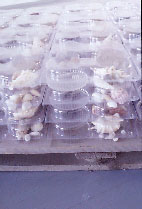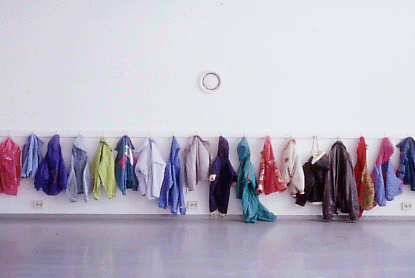|
|
 
J. Doyle:
Containers 2002, Back 2002. Photo: Patrick Rastenberger
Sets (or The broken-ess
of things): New Works by Jeanette Doyle
In mathematics, a set is a 'well defined' collection. Well defined
in this case refers to a clear possibility of determining whether
any given object / element is a member of the set or not. This
mathematical construct is both a wonderful and a complex idea
which has embedded within it a rich intellectual history: it hints
at a rather far reaching ambition to provide a unified grounding
for large swathes of mathematical theory. The richness of this
conceptual structure, which mathematics has tapped into, is arguably
something already intuitively present to our everyday trafficking
with the notion of a set. In the everyday, a set of things is
a collection that belongs together and suggests also the possibility
of something not belonging, of something ending up noticeably
or decidedly in the wrong context or place: in the wrong setting
as it were.
The apparent requirement that the artist should have an oeuvre,
a clearly defined set of works constituted by equally clear subsets
of elements (shows and projects), already participates in this
thinking of, in and through sets. The stylistic unity or thematic
continuity of the artworks is the principal required to establish
what is and what is not in the oeuvre. Peter Wollen posits a similar
construct in relation to cinema where he says: "my understanding
of auteurism[… was] that you had made a series of films which,
viewed as a unit , illuminated each other and formed a single
coherent body of work." [*] Within artworld practices the
catalogue of the work begins as the itemising list of the oeuvre.
In a related manner, the catalogue essay often emerges as the
attempted explication of the principals of unity subtending and
binding the work coherently together. But we can set about things
differently…
I can perhaps begin with time, as I appear to be already here
in the middle of time: things come together in time, they co-incide,
they endure however briefly and then they dissolve and break into
another constellation of possibilities. In the piece 'Back' the
children's coats are brought together from all the children's
coats in the world by all manner of accidents, selected to hang
on these hooks for a while, hanging at child's height.
Some other accident of insight might suggest that one coat is
a little more grown up or perhaps even a lot more grown up. It
belongs, in some way at least, further along the narrative of
a biography, a life. It might be worth noting that the artist
has pointed out that the jacket "is not meant to simply register
as a sinister presence" but rather "to suggest the inability
of an adult to inhabit the same space he or she has done as a
child."[**] Perhaps then this other coat is in the wrong
place or perhaps the wrong time or perhaps this is an accidental
moment of nostalgia or a moment of risk when the adult interrupts
the space and time of a child or perhaps this is just the right
setting, and all belongs here just as it happens to be. Just so.
It is the adult who invents childhood and it is the time-wary
adult who most urgently tries, and so earnestly tries, to set
things in a lasting order and establish things in their right
proportions. Time resists this setting in order retaining a disruptive
and dissolving fluidity.
Something of the anxiety of time is suggested in the piece entitled
'Set'. The set in question here is a set of crockery. This crockery
has been smashed with a hammer, reassembled using glue and presented
as if still substantially intact despite the holes from the hammer's
impact and the veined surfaces that testify to those shattering
blows. The catastrophe, it is thus suggested, has been overcome
and time undone, reversed and subverted. But what appears to abide
and endure is only the already broken-ess of things. The inutility
of the set argues the futility of the repair and the abandoned-ness
of things in the throes of time. No archaeological reconstruction
can overcome the loss (the loss of things, the loss of others,
our loss) but rather declares the abundance and hopelessness of
all this loss (all the more fretfully the more it obsesses and
fiddles at reconstruction).
In discussing this work and what might be written here, Jeanette
tells me that "'Nostalgic Landscapes' has yet to be made
[...]" We both hesitate and then laugh. This strange broken-ess
of things in time: the broken-ess of things such as ourselves
that project not only into the future, but into that future with
a specific orientation to the past (nostalgia), a future doubly
bound to the very fact of the loss of the past. The project of
painting a series of Irish landscapes from memory while resident
in Helsinki in this way reminds me of the poet who writes "I
search / for what I have not lost […] I would stop/ if I
knew how." [***] The potential absurdity of this temporality
is fully realised in the work 'Containers' which presents the
viewer with eighty clear plastic food containers with four compartments
containing sand, pebbles, seawater and a shell. Here, the prospect
of holding onto a piece of the seaside, a souvenir of a day in
sea, sand and sunshine is translated into the individualised pre-packaged
and sanitised commodity form. The commodity of course is a fetish
with which to ward off the threat of loss, the threat of time
and the unavowable inevitability of death. The form of the edible
portion suggests that oral ingestion of the thing is the only
hope of ever capturing, of ever fully possessing the thing. (It
is noteworthy that in a Duchampian play here, the 'ready-made'
becomes the 'take-away'.)
Despite the wry humour at work in these pieces, there is no wishing
away of the anxiety that is enacted in a work such as 'Fragments'.
"The characters which make up the words, which make up the
sentences, which make up the paragraph, which make up the page
are written directly on top of each other. So either a word or
a sentence or a page becomes a single character." The repetitive
labour which writes over each character in a sequence of text
is Sisyphean in its continuous action of undoing the last thing
done: each character written undoes the last character ultimately
generating an image constructed of the now illegible text. If
this question of anxiety is enacted in the process of these text-image
works it becomes palpable in 'Somebody Else's Shoes'.
In the same poem cited above, the writer continues: "I didn't
mean to mock you. I know there are people here/ - wretched, ill-fated
- / who have lost their worlds / in moments of truth." This
same insight seems to haunt 'Somebody Else's Shoes', a row of
worn shoes with their soles burnt. These shoes, these things have
travelled across the scorched earth. These things have crossed
through terrible things. These things, like all things, seem to
speak of other things elsewhere. This is part of the broken-ess
of things across time as played out in our thinking of things.
This is, and again I say 'perhaps', to do with the mindset of
things like ourselves that seek to set things in order even as
we precipitate catastrophe.
Mick Wilson, Dublin, April 2002.
Mick Wilson is an artist, lecturer and writer.
[*] P. Wollen, "Airports: A Personal Memoir", in David
Blamey (ed.) Here, There, Elsewhere: Dialogues on Location and
Mobility, London: Open Editions, 2002. (p. 106)
[**] Private correspondence with the artist, March 2002.
[***] T. Carmi "At The Stone of Losses"; G. Schulman
(trans.) in At The Stone of Losses, Philadelphia: Jewish Poetry
Series, 1983.
|
|